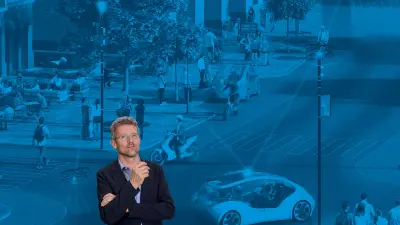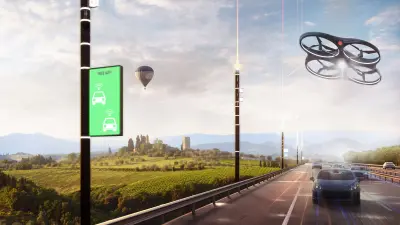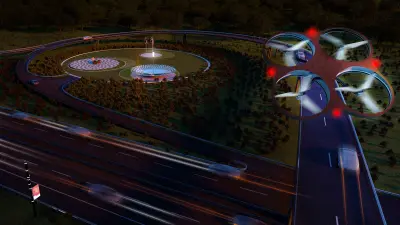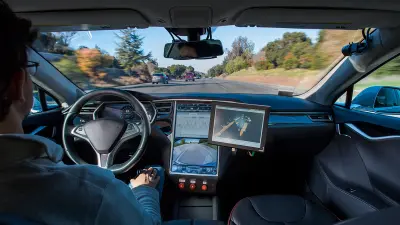How intelligent will future transportation be?
In dialogue with the director of the "Senseable City Lab" at MIT and founding partner of the CRA design and innovation practice

How will future transportation change our cities? Flying cars are not likely says Carlo Ratti, architect and engineer. Urban mobility will be revolutionized to a greater extent by car sharing, autonomous vehicles and smart roads.
“For 95 percent of the time, private vehicles are stationary in parking lots, traffic jams, and even parked at people’s homes,” is how Carlo Ratti describes the inefficient state of worldwide car usage. The engineer, architect and director of the “Senseable City Lab” at the Massachusetts Institute of Technology (MIT) feels the solution lies in car sharing concepts whose importance will increase exponentially with the growing number of automated vehicles: “Sharing a car can replace ten to 30 others.” Among other things, Ratti deals with the question of how future transportation systems will change urban life.
“Theoretically we could satisfy the mobility demand of a city with only a small fraction of the cars we have today.”
Sustainable transportation concept
According to Ratti, fully automated vehicles will revolutionize urban transportation: “They will dissolve the divide between private and public transportation. ‘Your’ car can drive you to work in the morning and then family members or somebody from your social media community can use it for the rest of the day.”

Carsharing and autonomous vehicles could mean fewer cars and therefore more space that could be put to other uses. Not only on the roads: “For every car in the United States, there are approximately three parking spaces — not including the private ones in front of houses. All in all, it totals about 13,000 square kilometers, which corresponds to an area bigger than Puerto Rico.” This space could be used for playgrounds or urban gardening — creativity knows no bounds when converting such free spaces.
Internet of Roads
That roads will also soon start to “think” is something made obvious by the “Smart Roads” project that is to be implemented on over 2,500 kilometers of roads in Italy. It has been developed together by the Italian infrastructure company ANAS and Carlo Ratti’s design and innovation practice Carlo Ratti Associati. “The aim is to improve traffic management and safety conditions on the roads. We want to place a digital layer over the existing physical infrastructure of the road network to exchange big data efficiently,” explains Ratti.
On these smart roads, drones will monitor traffic as well as the immediate surroundings, and in an emergency they can fly first aid kits to an accident. In doing so, they receive help from intelligent poles that serve the drones as charging stations, bundle their information and record environmental data like air pollution, wind speed or weather changes. These are then transmitted to smartphones or on-board navigation systems belonging to today’s drivers and the autonomous vehicles of tomorrow. They also provide drivers in real time with personalized information about for instance the traffic situation or upcoming road conditions. The next step on the way to an “Internet of Roads” scenario will be to link this data with information collected by the vehicles themselves. A wi-fi system integrated within the poles ensures that everybody travelling on the road stays online.

Becoming more flexible
According to Ratti, infrastructure will not undergo any essential changes. What on the other hand will dramatically change is urban areas and life: “The digital and physical world will merge — a totally new experience of the city.” It is all about flexibility and user orientation. Ratti cites the “Dynamic Street” project as a current example — a prototype that Ratti and his colleagues have developed with Sidewalk Labs, a start-up belonging to the Google parent company Alphabet.
The dynamic street adapts to its users in real time thanks to an IoT system: “A street where automated cars drive in the morning, children play in the afternoon, and which becomes a baseketball court on the weekend,” is how Ratti describes the concept. Light signals serve as markings for parking spaces or traffic lanes. This way an additional lane can be added for example during rush hour and then disappears in the evening.
A question of funding
The new technologies come with challenges: “Autonomous vehicles could lead to an unfair competitive advantage. The cost of traveling a mile might sink to such a degree that people will abandon public transportation in favor of self-driving cars.” The result would be more cars back on our streets and roads.

Relief could come in the form of a tax on individual mobility and subsidies for public transport. It however raises complex funding issues: “I see dynamic road pricing systems like those in Singapore as a possible source of income,” explains Ratti. It would mean pay stations in areas with heavy traffic. With integrated chips in vehicles, drivers would pay a toll that varies depending on the time of day and traffic. The results are positive — less traffic jams and a more efficient utilization of roads. In general, Ratti stresses that one should not only rely on cars but efficiently combine various means of transportation — like e-scooter services, public transport or e-bike sharing.
Don’t take off
However, “air taxis” or “flying cars” play no role in Ratti’s vision: “They are to be seen in films like Metropolis or Blade Runner and are in the imaginations of investors but I think that, even now, cars on roads are dangerous. Just imagine what it’d be like in the air. In my opinion, we should stay firmly on the ground when it comes to transport.”
Profile

Carlo Ratti
Director of the “Senseable City Lab“ at the MIT and founding partner of "Carlo Ratti Associati" design and innovation practice in New York and Turin
We want to place a digital layer over the existing physical infrastructure of the road network to exchange big data efficiently.
Carlo Ratti is an architect and engineer. He graduated from the École Nationale des Ponts et Chaussées in Paris and the Politecnico di Torino. In 2001, he earned his MPhil and PhD at Cambridge University. Since 2003, he has been directing the “Senseable City Lab“ at the Massachusetts Institute of Technology (MIT), a research facility that focuses on how digital technologies will change people's lives. He is also a founding partner of the international design and innovation practice “Carlo Ratti Associati" in New York and Turin.
Photo: © Brendan Zhang
Summary
According to Carlo Ratti, the city of the future is flexible and adapts itself to its inhabitants thanks to big data. He is convinced that when the digital and physical worlds merge, it can revolutionize urban transportation, dissolve infrastructure issues and increase quality of life.

